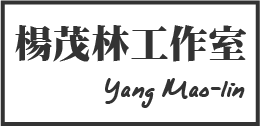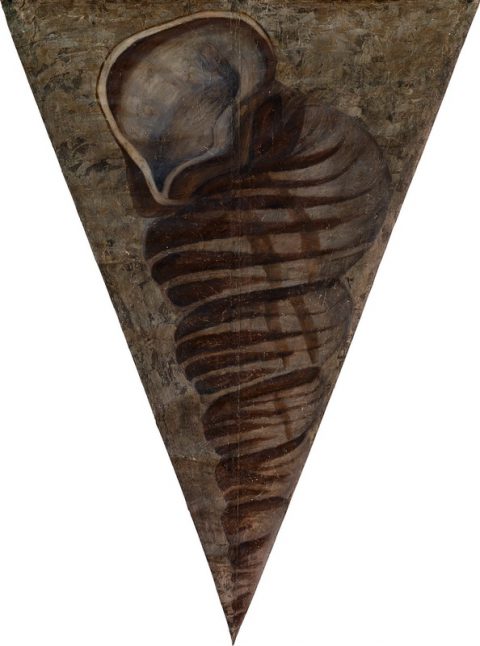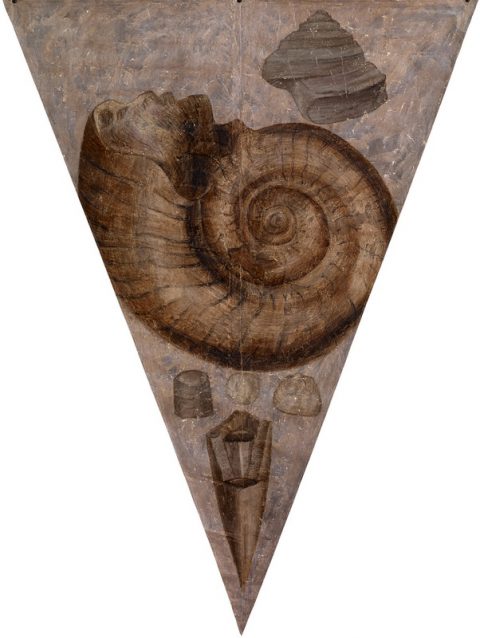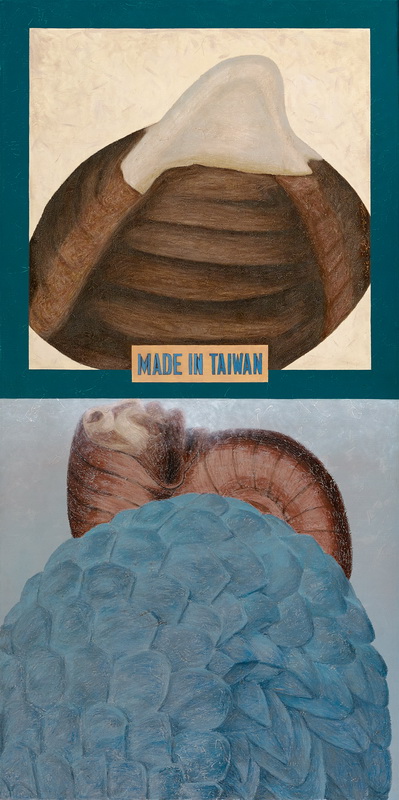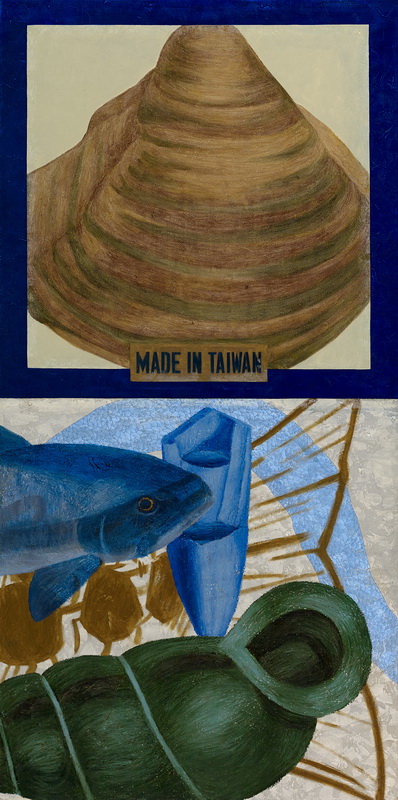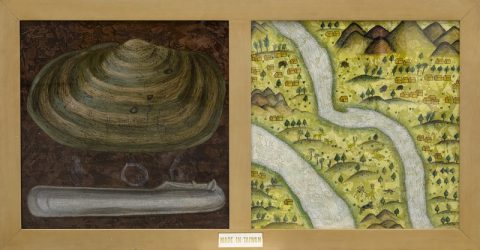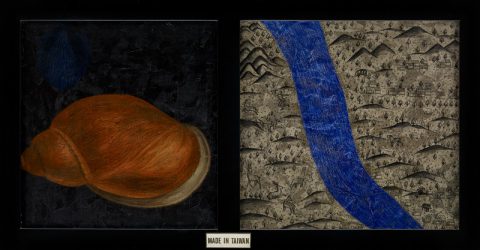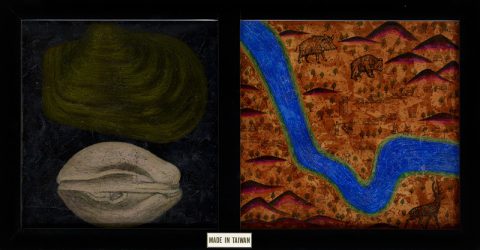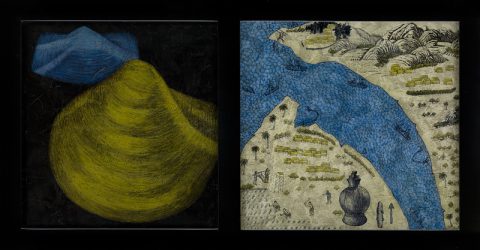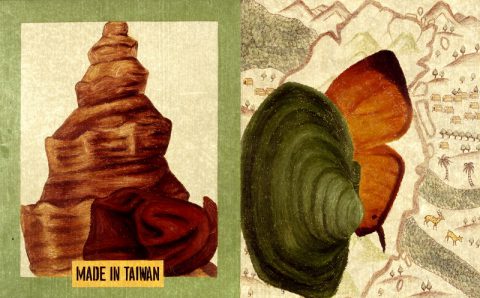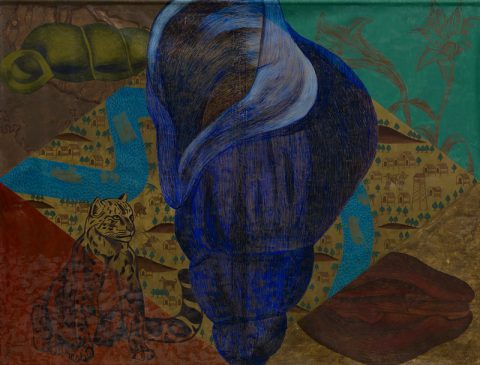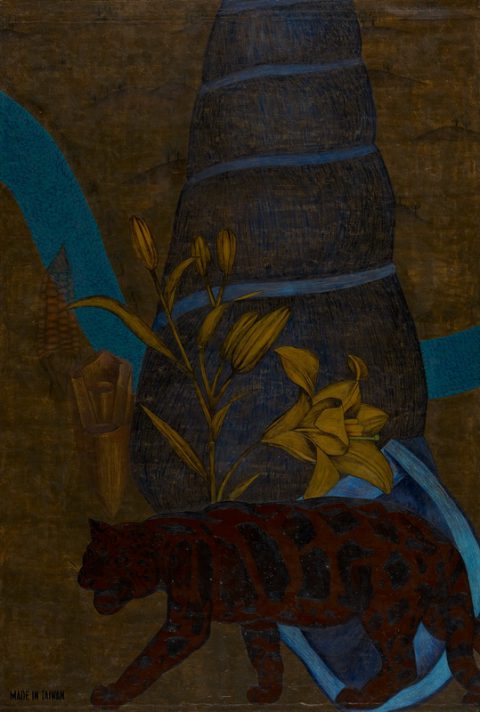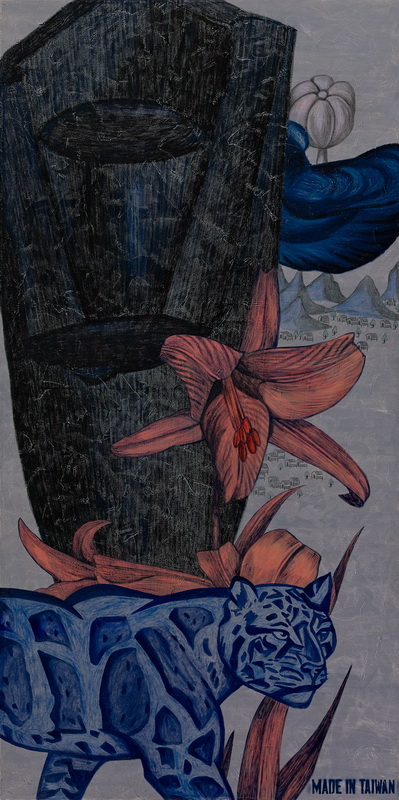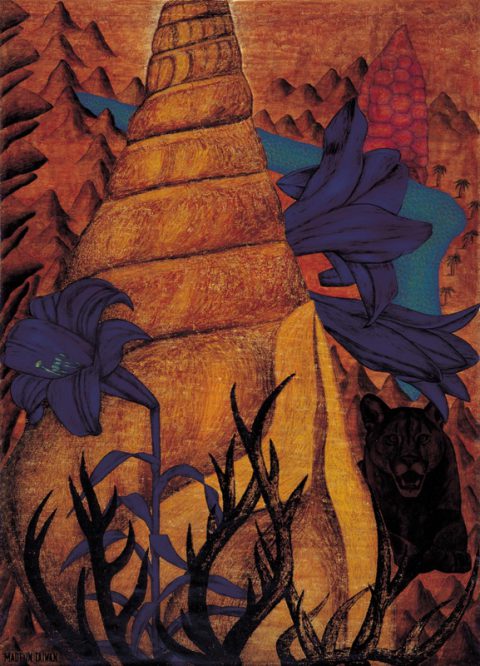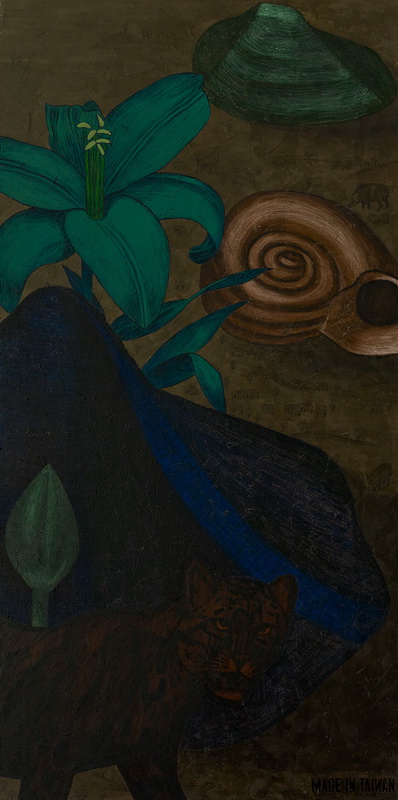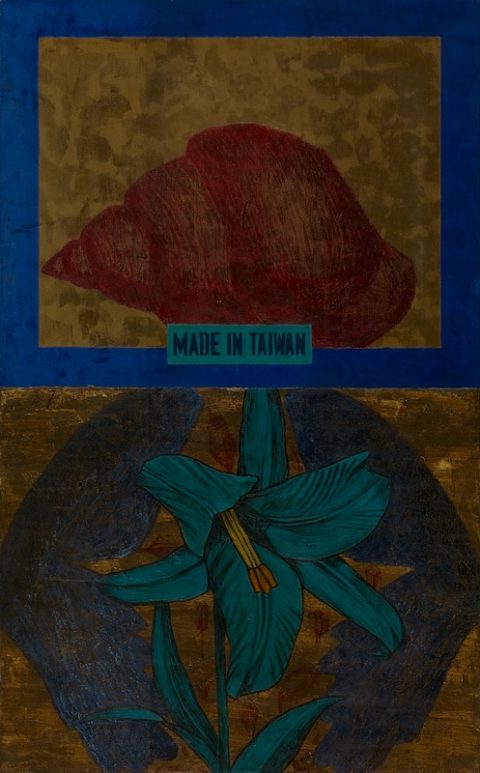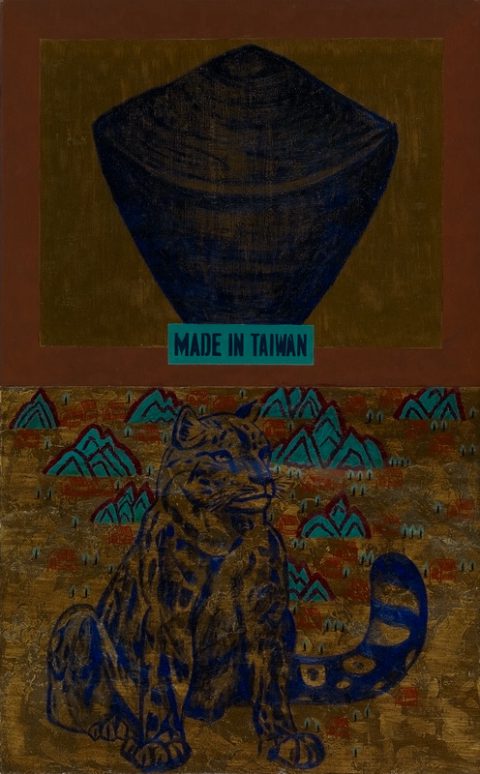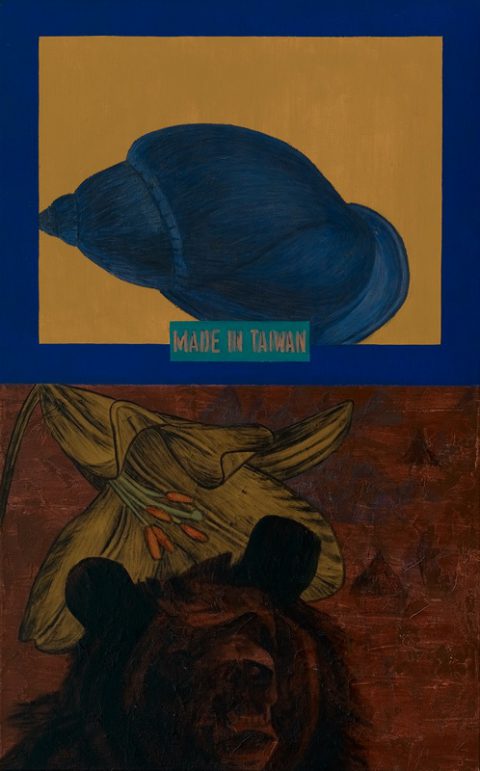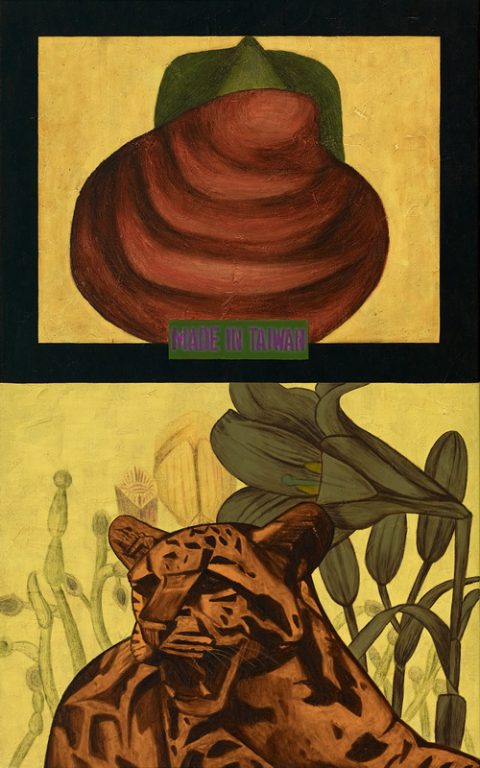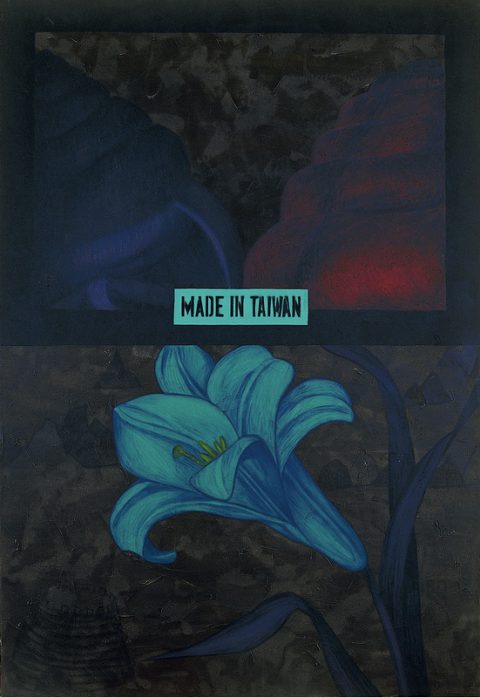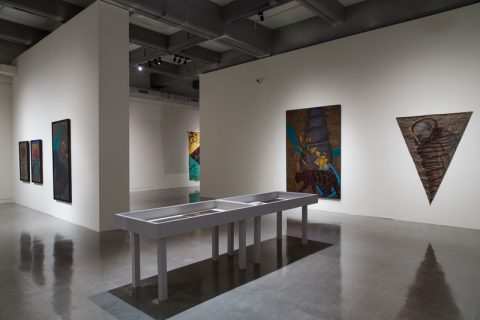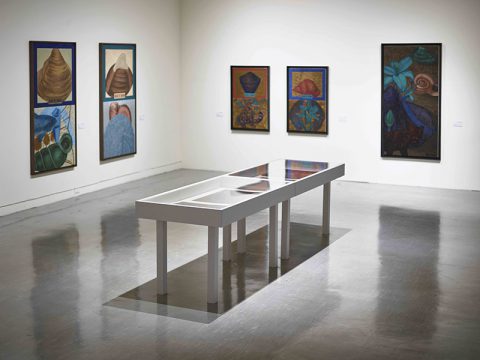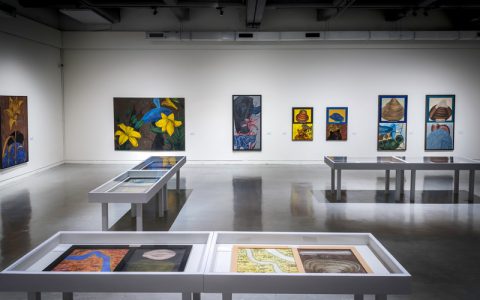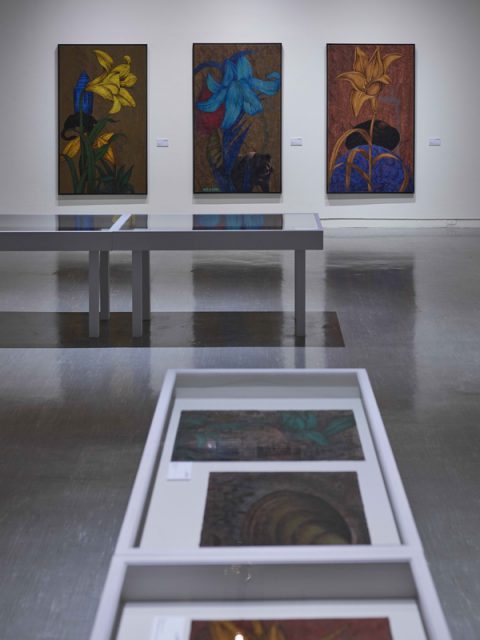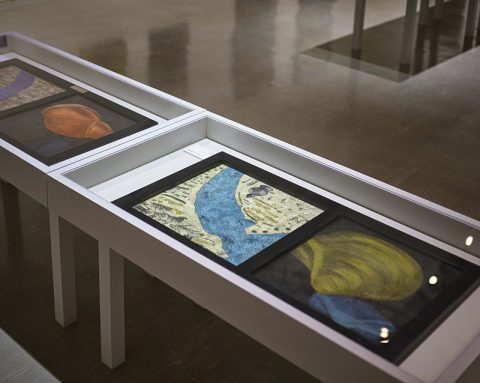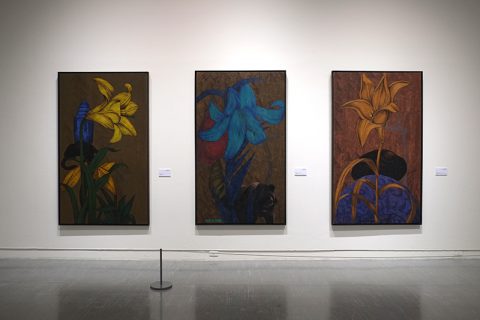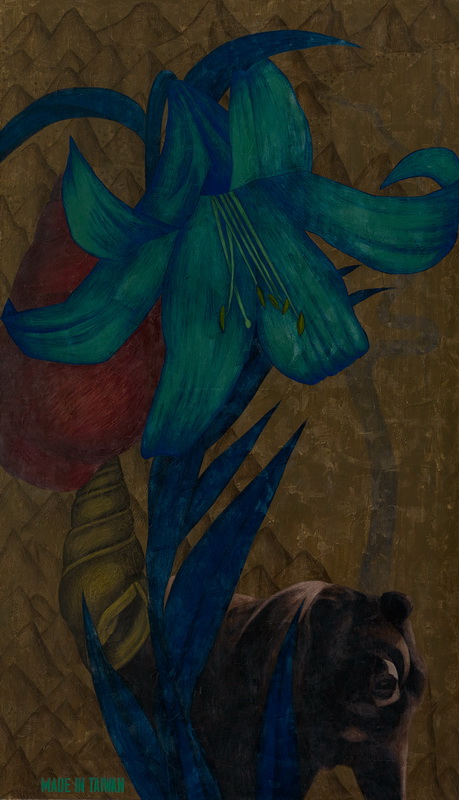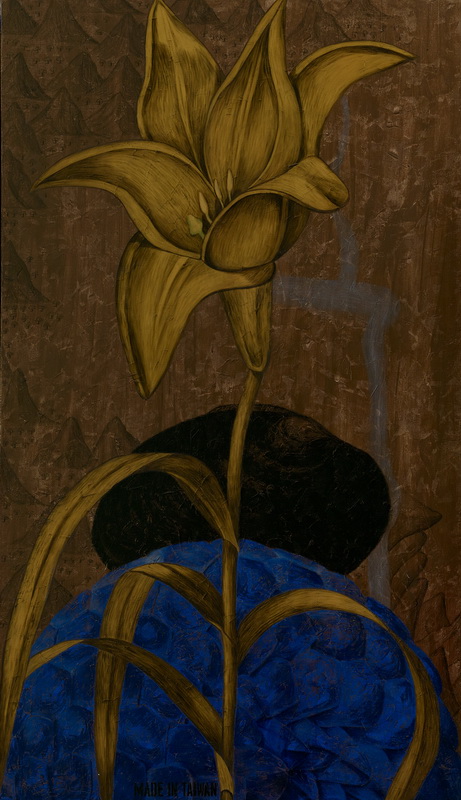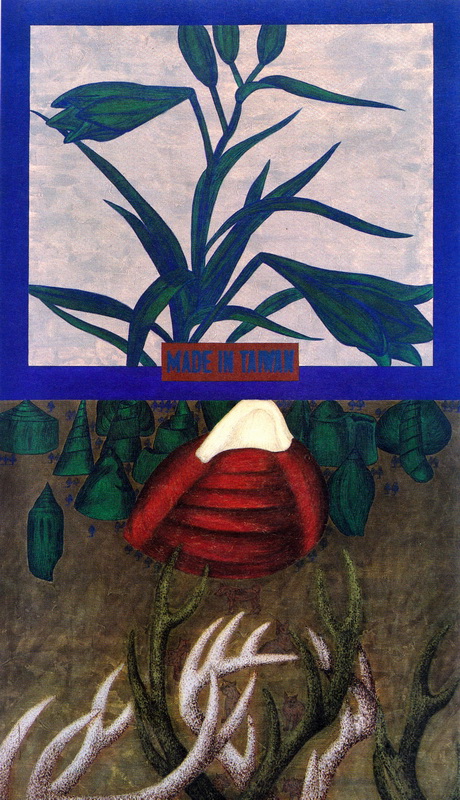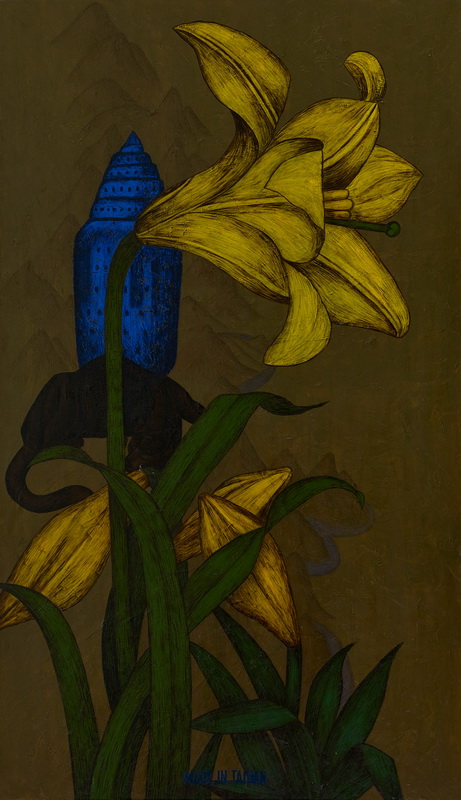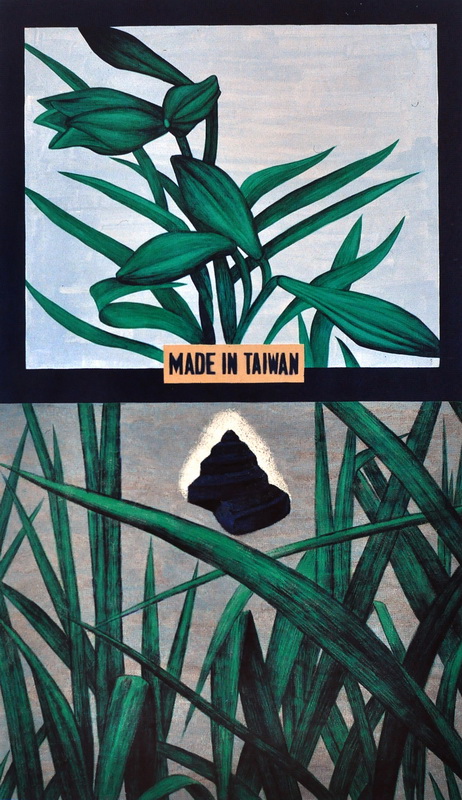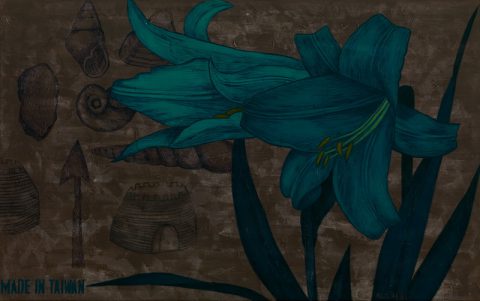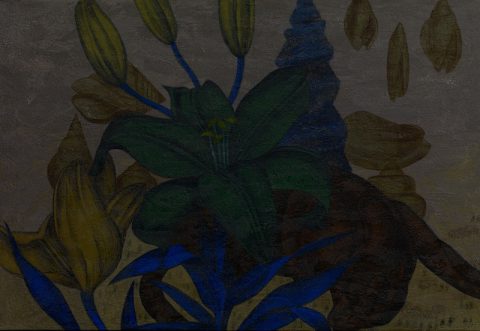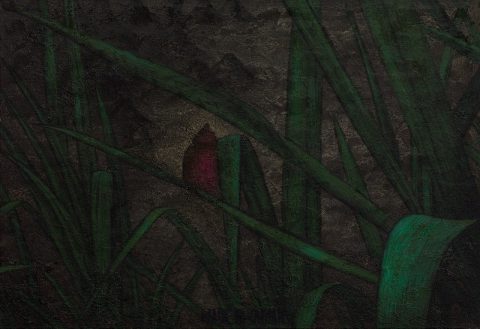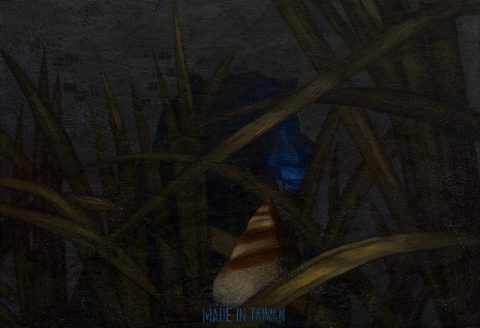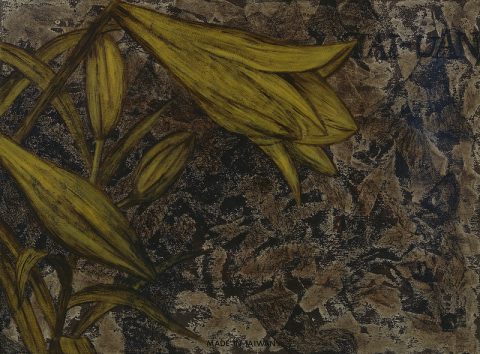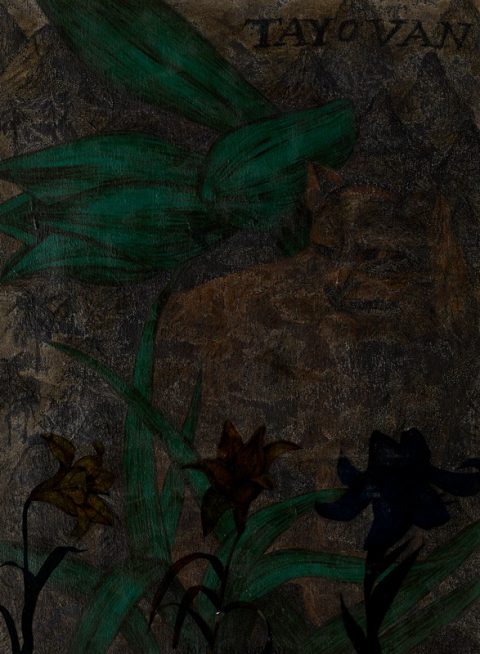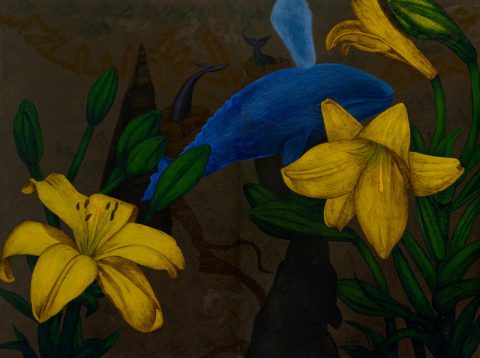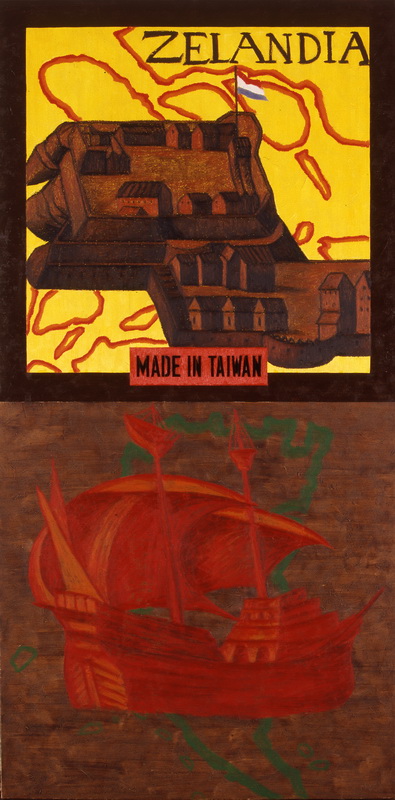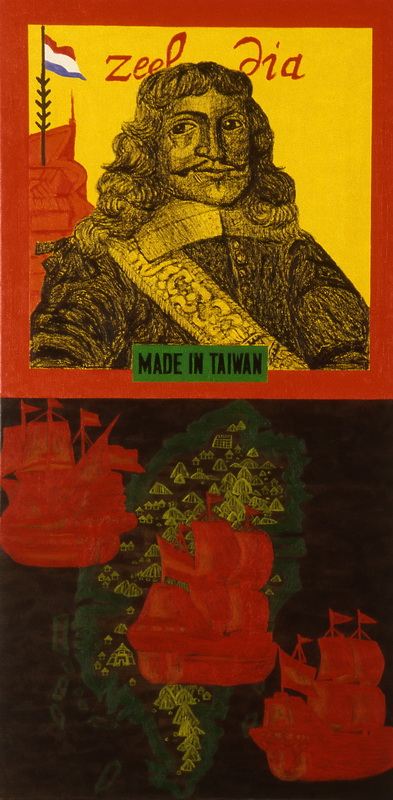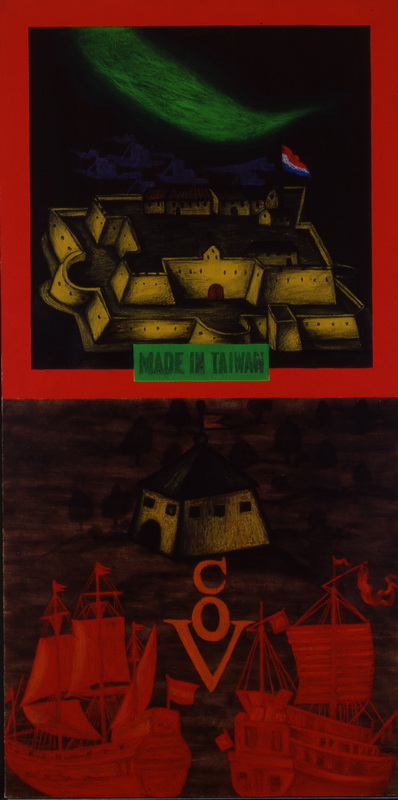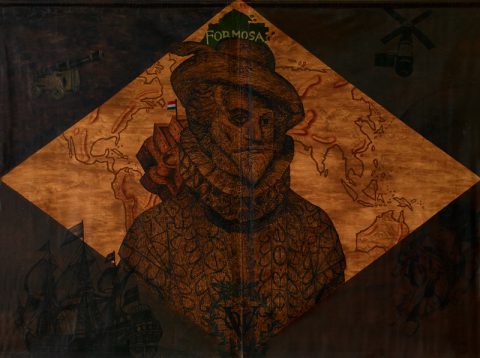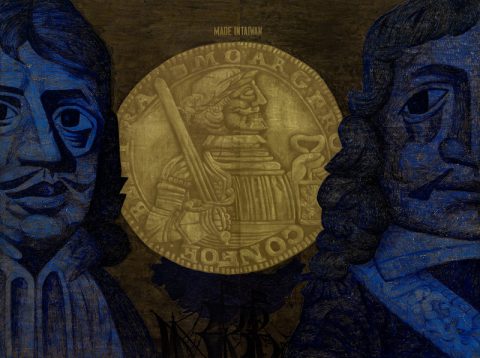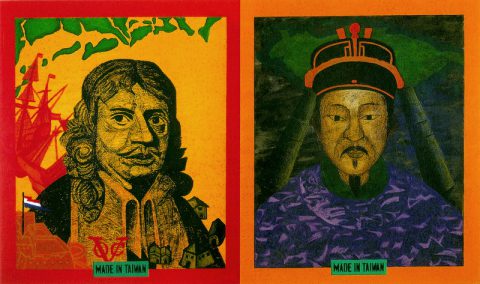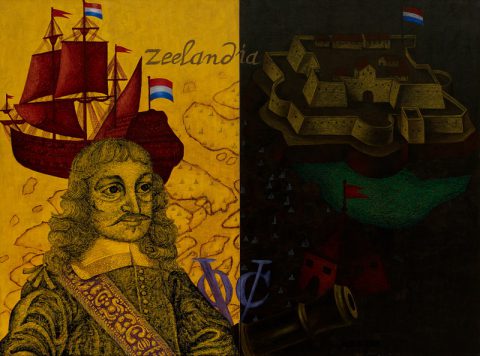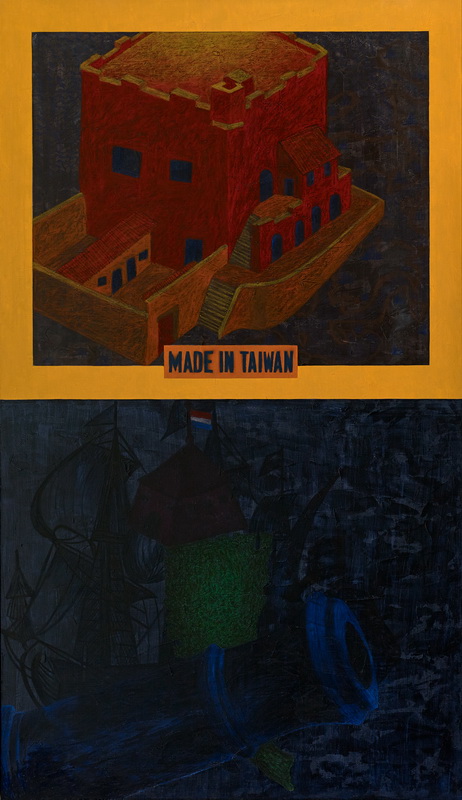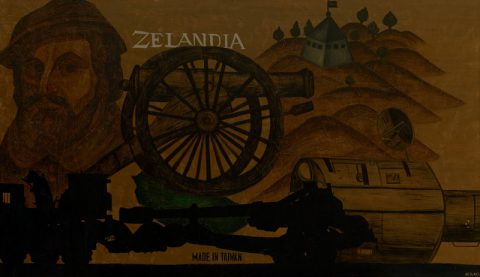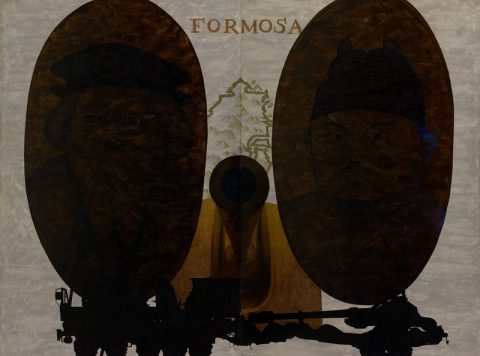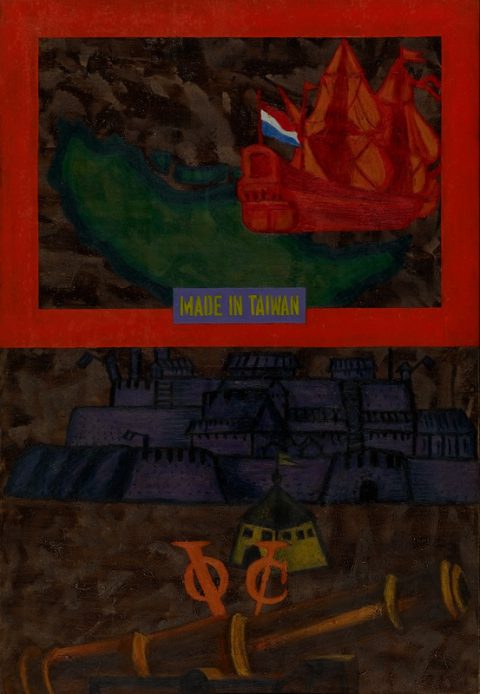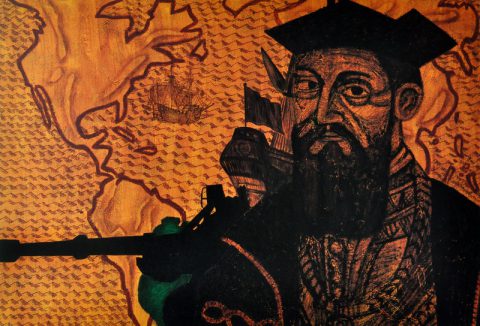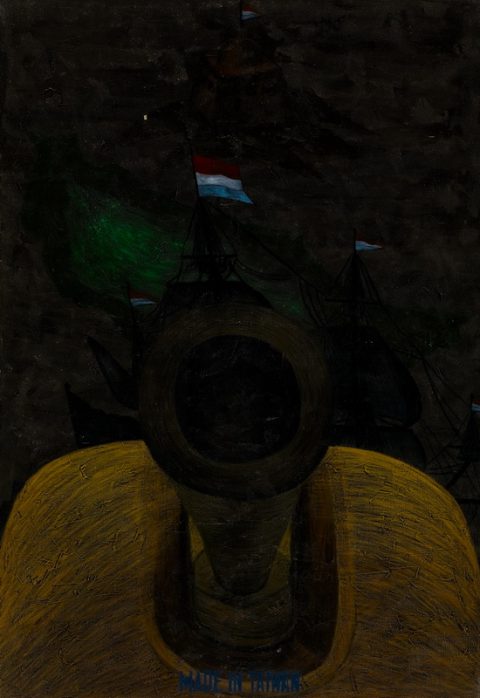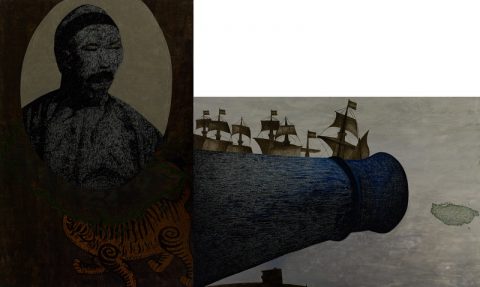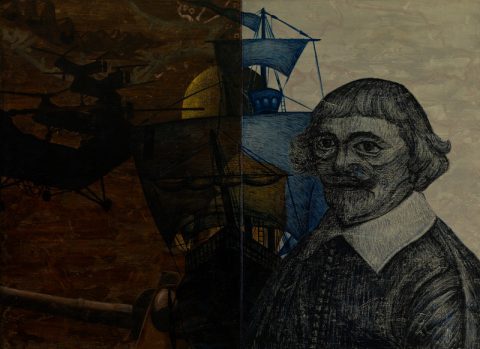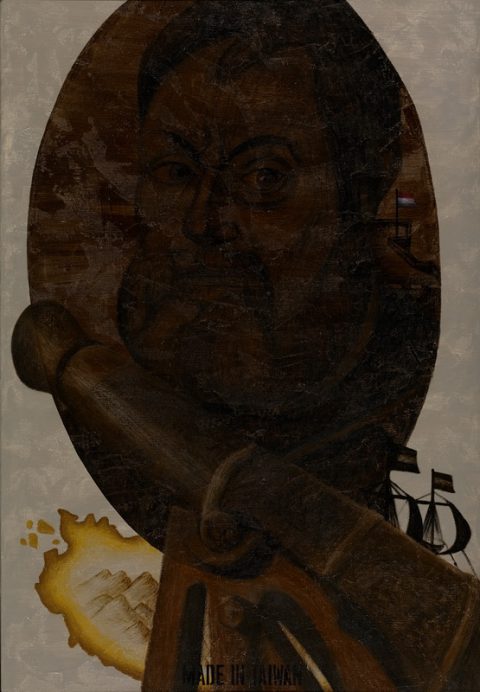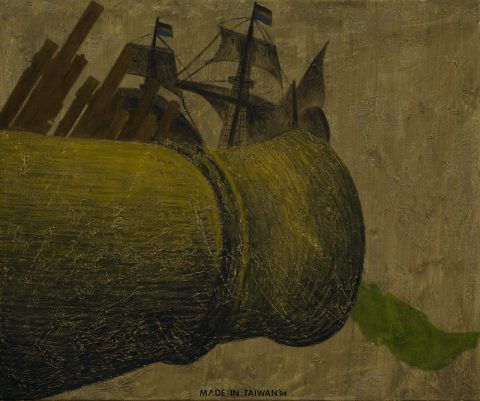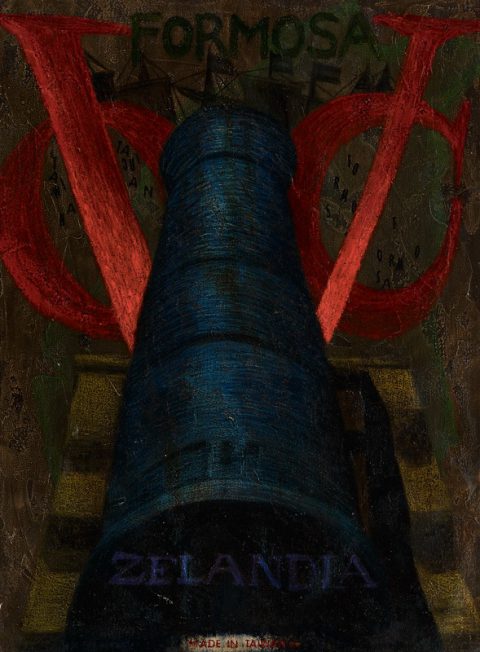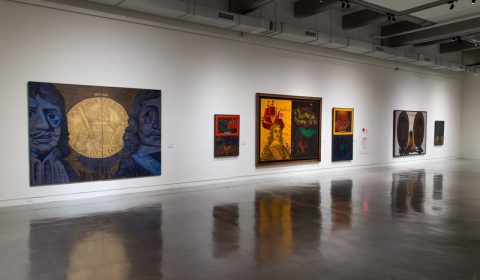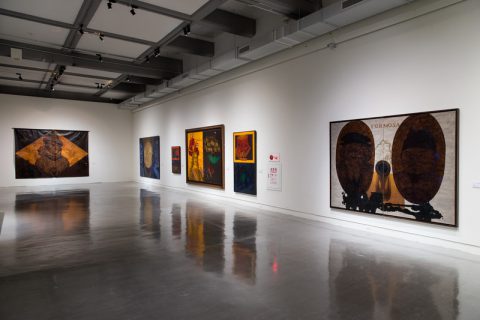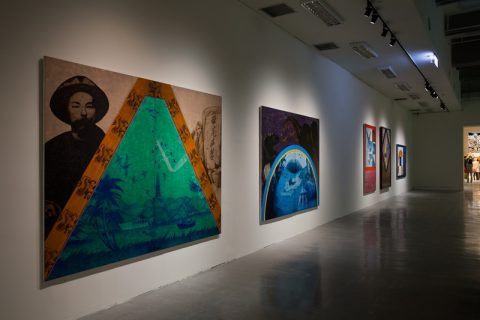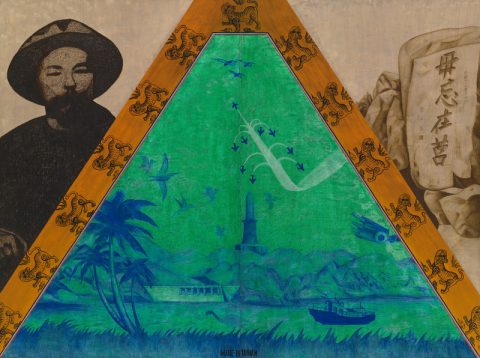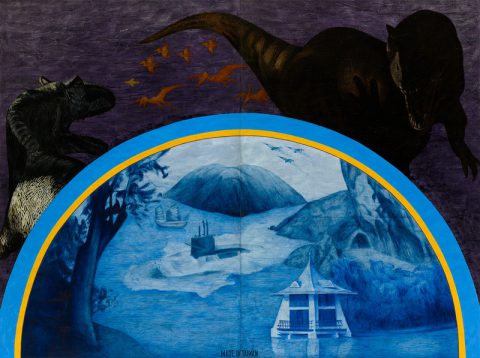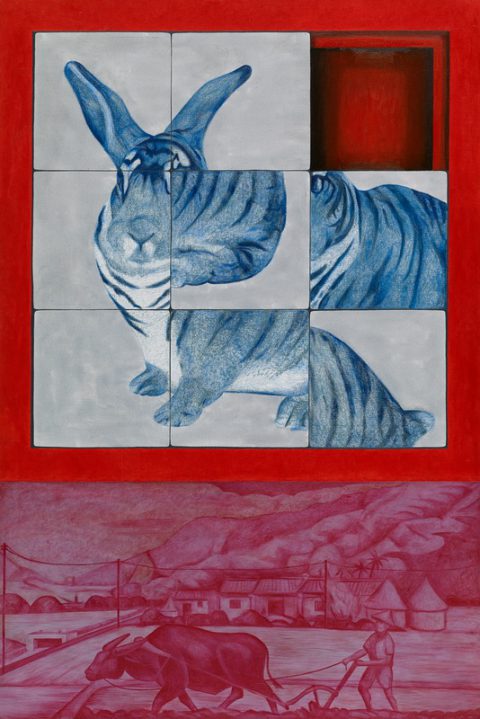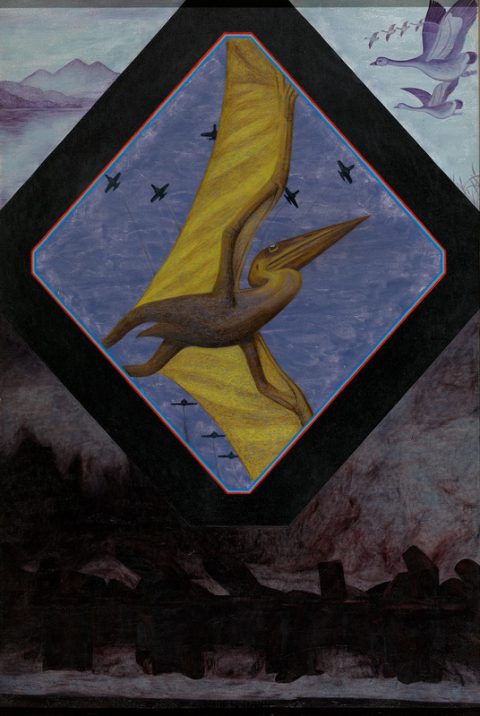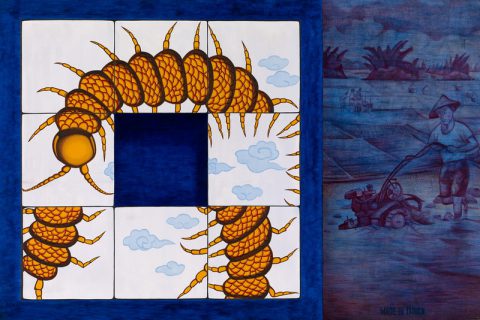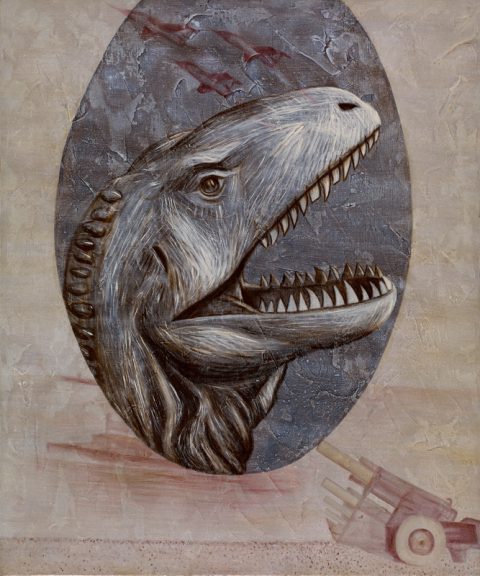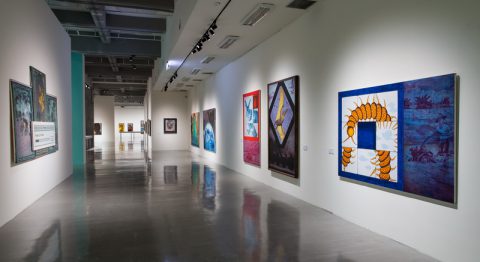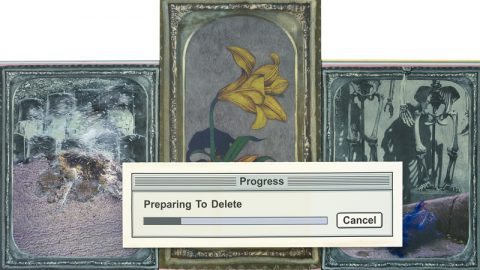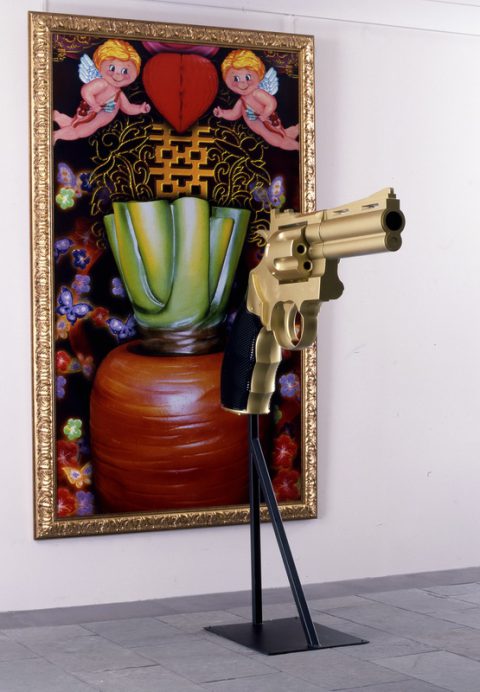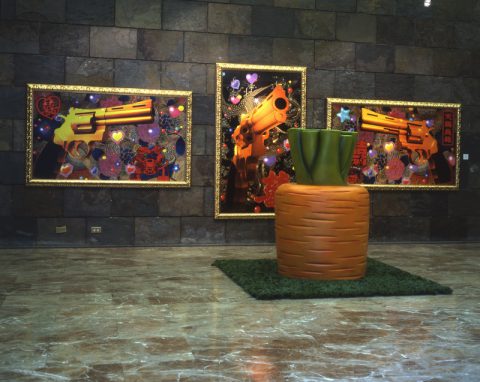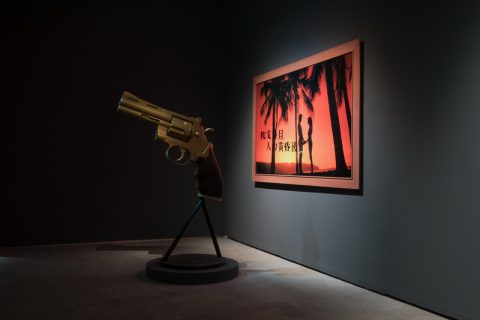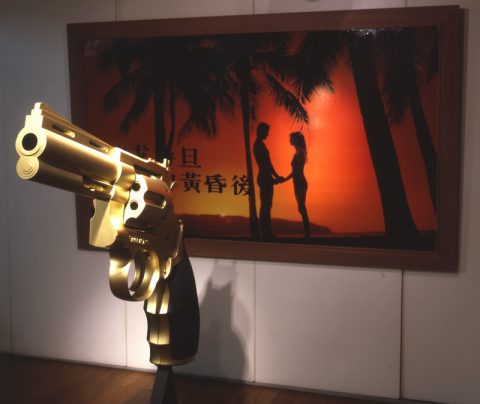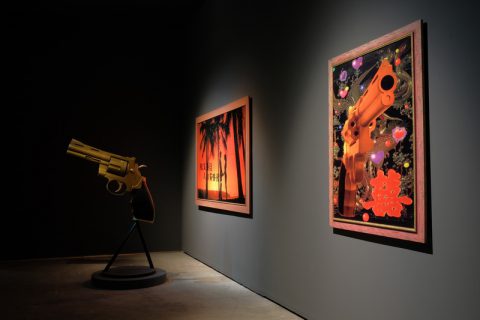1991-1999
圓山紀事 | 百合紀事 | 熱蘭遮紀事 | 大員紀事
繼「MADE IN TAIWAN政治篇」之後的「歷史篇」共有四個單元,包括:「圓山紀事」、「百合紀事」、「熱蘭遮紀事」、與「大員紀事」,內容是關於台灣原住民、外來族群殖民、清朝治理台灣時期,至十九世紀末的歷史斷代。楊茂林企圖以其擅長的圖像風格重新詮釋、整理台灣的歷史,且不依照編年的歷史概念,而是以片斷、多元時空的敘述法則,建構出新的歷史存在感,同時也顛覆了既有的、主流的、正統的史觀。他依照個人的記憶,提出不同的歷史論證,以開放的形式去理解歷史文化錯綜複雜的關係。
在形式上,「MADE IN TAIWAN歷史篇」規格化的傾向是借用人類學、考古學基礎研究的田野調查方法;橫向或縱向的雙拼結構則強化了作為考古文物的意含,蓋上「MADE IN TAIWAN」的標誌(也可說是標籤)後,更保有一致性,如同在博物館羅列展示的出土文物標本。
MADE IN TAIWAN—History Section | 1991-1999
Yun Mountain Memorandum、 Lily Memorandum、Zeelandia Memorandum、 Tayouan Memorandum
After MADE IN TAIWAN—Political Section, Yang followed up with his “History Section,” comprising four parts: Yun Mountain Memorandum, Lily Memorandum, Zeelandia Memorandum and Tayouan Memorandum. The series concerns successive historical periods in Taiwan until the end of the nineteenth century, from aboriginal peoples to foreign colonizers and the Qing Dynasty administration of Taiwan. Yang reinterprets this history using his skillful graphic-art style. Furthermore, he does not rely on a chronological concept of history but rather a fragmented narrative presenting multiple chronotopes to construct a new historical reality and subvert mainstream, orthodox views. Using his own recollections to put forth different historical arguments, Yang liberates form to interpret complex relationships in Taiwanese history and culture.
Formal standards for MADE IN TAIWAN—History Section tend toward field study, which is the research foundation of anthropology and archaeology. Yang collaged images in either horizontal or vertical orientations to emphasize that they belong to these fields of study. Also, signifying “MADE IN TAIWAN” (or affixing this label), which is a strategy used for unearthed artifacts displayed in a museum, maintains a certain consistency throughout Yang’s series.
▲ ▼
圓山紀事 Yun Mountain Memorandum
圓山紀事L9101|綜合媒材|214x159cm|1991
Yun Mountain Memorandum L9101|mixed media|214x159cm|1991
圓山紀事L9102|綜合媒材|214x160cm|1991
Yun Mountain Memorandum L9102|mixed media|214x160cm|1991
圓山紀事L9103|綜合媒材|194x97cm|1991
Yun Mountain Memorandum L9103|mixed media|194x97cm|1991
圓山紀事L9105|綜合媒材|194x97cm|1991
Yun Mountain Memorandum L9105|mixed media|194x97cm|1991
圓山紀事M9108|綜合媒材|67x129cm|1991
Yun Mountain Memorandum M9108|mixed media|67x129cm|1991
圓山紀事M9109|綜合媒材|67x129cm|1991
Yun Mountain Memorandum M9109|mixed media|67x129cm|1991
圓山紀事M9110 |綜合媒材|67x129cm|1991
Yun Mountain Memorandum M9110|mixed media|67x129cm|1991
圓山紀事M9112|綜合媒材|67x129cm|1991
Yun Mountain Memorandum M9112|mixed media|67x129cm|1991
圓山紀事M9117|綜合媒材|73x116cm|1991
Yun Mountain Memorandum M9117|mixed media|73x116cm|1991
圓山紀事XL9201|油彩、壓克力顏料、畫布|263x350cm|1992
Yun Mountain Memorandum XL9201|oil, acrylic on canvas|263x350cm|1992
圓山紀事L9207|油彩、壓克力顏料、畫布|259x182cm|1992
Yun Mountain Memorandum L9207|oil, acrylic on canvas|259x182cm|1992
圓山紀事L9209|油彩、壓克力顏料、畫布|194x97cm|1992
Yun Mountain Memorandum L9209|oil, acrylic on canvas|194x97cm|1992
圓山紀事L9215|油彩、壓克力顏料、畫布|259x182cm|1992
Yun Mountain Memorandum L9215|oil, acrylic on canvas|259x182cm|1992
圓山紀事L9216|油彩、壓克力顏料、畫布|194x97cm|1992
Yun Mountain Memorandum L9216|oil, acrylic on canvas|194x97cm|1992
圓山紀事M9206|油彩、壓克力顏料、畫布|116.5x73cm|1992
Yun Mountain Memorandum M9206|oil, acrylic on canvas|116.5x73cm|1992
圓山紀事M9207|油彩、壓克力顏料、畫布|116x73cm|1992
Yun Mountain Memorandum M9207|oil, acrylic on canvas|116x73cm|1992
圓山紀事M9225|油彩、壓克力顏料、畫布|122x77cm|1992
Yun Mountain Memorandum M9225|oil, acrylic on canvas|122x77cm|1992
圓山紀事M9229|油彩、壓克力顏料、畫布|122x77cm|1992
Yun Mountain Memorandum M9229|oil, acrylic on canvas|122x77cm|1992
圓山紀事M9302|油彩、壓克力顏料、畫布|91x117cm|1993
Yun Mountain Memorandum M9302|oil, acrylic on canvas|91x117cm|1993
百合紀事 Lily Memorandum
百合紀事L9301|油彩、壓克力顏料、畫布|194x112cm|1993
Lily Memorandum L9301|oil, acrylic on canvas|194x112cm|1993
百合紀事L9302|油彩、壓克力顏料、畫布|194x112cm|1993
Lily Memorandum L9302|oil, acrylic on canvas|194x112cm|1993
百合紀事L9303|油彩、壓克力顏料、畫布|194x112cm|1993
Lily Memorandum L9303|oil, acrylic on canvas|194x112cm|1993
百合紀事L9304|油彩、壓克力顏料、畫布|194x112cm|1993
Lily Memorandum L9304|oil, acrylic on canvas|194x112cm|1993
百合紀事L9306|油彩、壓克力顏料、畫布|194x112cm|1993
Lily Memorandum L9306|oil, acrylic on canvas|194x112cm|1993
百合紀事M9301|油彩、壓克力顏料、畫布|73x116cm|1993
Lily Memorandum M9301|oil, acrylic on canvas|73x116cm|1993
百合紀事M9302|油彩、壓克力顏料、畫布|80x117cm|1993
Lily Memorandum M9302|oil, acrylic on canvas|80x117cm|1993
百合紀事M9303|油彩、壓克力顏料、畫布|80×116.5cm|1993
Lily Memorandum M9303|oil, acrylic on canvas|80×116.5cm|1993
百合紀事M9304|油彩、壓克力顏料、畫布|80×116.5cm|1993
Lily Memorandum M9304|oil, acrylic on canvas|80×116.5cm|1993
百合紀事SM9301|油彩、壓克力顏料、油畫紙|57x77cm|1993
Lily Memorandum SM9301|oil, acrylic on paper|57x77cm|1993
百合紀事SM9302|油彩、壓克力顏料、油畫紙|77x57cm|1993
Lily Memorandum SM9302|oil, acrylic on paper|77x57cm|1993
百合紀事L9401|油彩、壓克力顏料、畫布|194x260cm|1994
Lily Memorandum L9401|oil, acrylic on canvas|194x260cm|1994
熱蘭遮紀事 Zeelandia Memorandum
熱蘭遮紀事L9201|油彩、壓克力顏料、畫布|193x97cm|1992
Zeelandia Memorandum L9201|oil, acrylic on canvas|193x97cm|1992
熱蘭遮紀事L9202|油彩、壓克力顏料、畫布|193x97cm|1992
Zeelandia Memorandum L9202|oil, acrylic on canvas|193x97cm|1992
熱蘭遮紀事L9203|油彩、壓克力顏料、畫布|194x97cm|1992
Zeelandia Memorandum L9203|oil, acrylic on canvas|194x97cm|1992
熱蘭遮紀事XL9301|油彩、壓克力顏料、畫布|260x350cm|1993
Zeelandia Memorandum XL9301|oil, acrylic on canvas|260x350cm|1993
熱蘭遮紀事XL9302|油彩、壓克力顏料、畫布|218x292cm|1993
Zeelandia Memorandum XL9302|oil, acrylic on canvas|218x292cm|1993
熱蘭遮紀事L9301|油彩、壓克力顏料、畫布|112x194cm|1993
Zeelandia Memorandum L9301|oil, acrylic on canvas|112x194cm|1993
熱蘭遮紀事L9302|油彩、壓克力顏料、畫布|194x260cm|1993
Zeelandia Memorandum L9302|oil, acrylic on canvas|194x260cm|1993
熱蘭遮紀事L9303|油彩、壓克力顏料、畫布|194x112cm|1993
Zeelandia Memorandum L9303|oil, acrylic on canvas|194x112cm|1993
熱蘭遮紀事L9304|油彩、壓克力顏料、畫布|112x194cm|1993
Zeelandia Memorandum L9304|oil, acrylic on canvas|112x194cm|1993
熱蘭遮紀事L9307|油彩、壓克力顏料、畫布|194x260cm|1993
Zeelandia Memorandum L9307|oil, acrylic on canvas|194x260cm|1993
熱蘭遮紀事M9301|油彩、壓克力顏料、畫布|117x80cm|1993
Zeelandia Memorandum M9301|oil, acrylic on canvas|117x80cm|1993
熱蘭遮紀事M9303|油彩、壓克力顏料、畫布|117x80cm|1993
Zeelandia Memorandum M9303|oil, acrylic on canvas|117x80cm|1993
熱蘭遮紀事M9304|油彩、壓克力顏料、畫布|117x80cm|1993
Zeelandia Memorandum M9304|oil, acrylic on canvas|117x80cm|1993
熱蘭遮紀事L9401|油彩、壓克力顏料、畫布|194x324cm|1994
Zeelandia Memorandum L9401|oil, acrylic on canvas|194x324cm|1994
熱蘭遮紀事L9404|油彩、壓克力顏料、畫布|116.5x160cm|1994
Zeelandia Memorandum L9404|oil, acrylic on canvas|116.5x160cm|1994
熱蘭遮紀事M9402|油彩、壓克力顏料、畫布|117x80cm|1994
Zeelandia Memorandum M9402|oil, acrylic on canvas|117x80cm|1994
熱蘭遮紀事SM9403|油彩、壓克力顏料、油畫紙|60.5×72.5cm|1994
Zeelandia Memorandum SM9403|oil, acrylic on paper|60.5×72.5cm|1994
熱蘭遮紀事SM9404|油彩、壓克力顏料、油畫紙|77x57cm|1994
Zeelandia Memorandum SM9404|oil, acrylic on paper|77x57cm|1994
大員紀事 Tayouan Memorandum
大員紀事.毋忘在莒L9501|油彩、壓克力顏料、畫布|194x260cm|1995
Tayouan Memorandum.Separations L9501|oil, acrylic on canvas|194x260cm|1995
大員紀事.龍L9501|油彩、壓克力顏料、畫布|194x260cm|1995
Tayouan Memorandum.Dragon L9501|oil, acrylic on canvas|194x260cm|1995
大員紀事.虎L9501|油彩、壓克力顏料、畫布|218x146cm|1995
Tayouan Memorandum.Tiger L9501|oil, acrylic on canvas|218x146cm|1995
大員紀事.鳳L9501|油彩、壓克力顏料、畫布|218x146cm|1995
Tayouan Memorandum.Phoenix L9501|oil, acrylic on canvas|218x146cm|1995
大員紀事.龍L9502|油彩、壓克力顏料、畫布|146x218cm|1995
Tayouan Memorandum.Dragon L9502|oil, acrylic on canvas|146x218cm|1995
大員紀事.龍SM9501|油彩、壓克力顏料、畫布|73x60cm|1995
Tayouan Memorandum.Dragon SM9501|oil, acrylic on canvas|73x60cm|1995
大員紀事.資料準備刪除中|油彩、電腦製作在畫布|194x354cm|1998
Tayouan Memorandum.Preparing to Delete Date|oil, computer graphic on canvas|194x354cm|1998
大員紀事.天作之合I|影像輸出、銅|194×112cm、169x110x40cm|1999
Tayouan Memorandum.Born to be Together I|digital print on photo paper, copper|194×112cm、169x110x40cm|1999
大員紀事.天作之合II|裝置|圖212x130cmx3|1999
Tayouan Memorandum.Born to be Together II|installation|image 212x130cmx3|1999
大員紀事–枕戈待旦.人約黃昏|壓克力顏料、影像輸出、銅|130x212cm、169x110x40cm|1999
Tayouan Memorandum- Ready to Fight.A Nightfall Date|acrylic, digital print on photo paper, copper|130x212cm、169x110x40cm|1999
大員紀事–枕戈待旦.人約黃昏(局部)
Tayouan Memorandum- Ready to Fight.A Nightfall Date (part)
